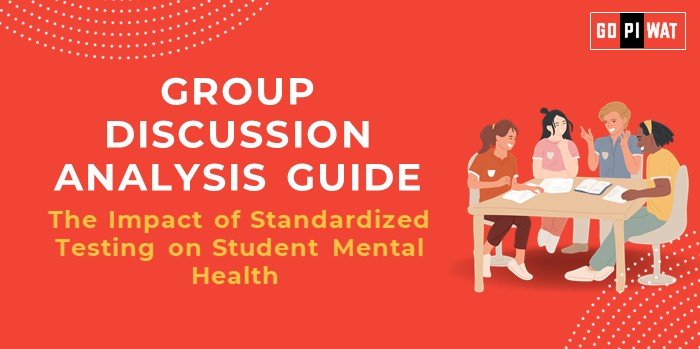📋 GD Guide: The Impact of Standardized Testing on Student Mental Health
🌐 Introduction to the Topic
Opening Context: Standardized testing has become a cornerstone of modern education systems globally, serving as a primary tool for academic assessment and institutional evaluation. However, its impact on student mental health has sparked debates in both academic and public forums.
Topic Background: Originating in the early 20th century to ensure uniformity in educational assessment, standardized tests have proliferated worldwide. While they offer measurable benchmarks, their psychological implications for students—such as stress, anxiety, and burnout—pose significant challenges.
📊 Quick Facts and Key Statistics
– 😟 Stress Levels: A 2022 survey found that 60% of high school students reported test-related anxiety.
– 🔥 Burnout Rates: Studies show a 25% increase in academic burnout among students in high-testing environments.
– 💼 Parental Pressure: In India, 75% of students feel parental pressure to excel in board examinations.
– 🌟 Alternative Methods: Finland, ranked among the top educational systems globally, does not emphasize standardized testing until later stages of education.
👥 Stakeholders and Their Roles
- 👨🎓 Students: Bear the brunt of testing pressures, impacting mental health and academic performance.
- 👨👩👧👦 Parents: Often inadvertently add to stress through high expectations.
- 👩🏫 Educators: Balance curriculum demands with the holistic development of students.
- 🏛️ Governments: Advocate for testing as a tool for national educational benchmarking.
- 🧠 Psychologists: Provide insights into the mental health impacts and propose interventions.
🏆 Achievements and Challenges
✨ Achievements:
- ✔️ Objective Evaluation: Standardized tests offer measurable benchmarks for academic achievement.
- ✔️ Policy Insights: Data from tests aid in identifying gaps in national education systems.
- ✔️ Scholarship Opportunities: Results enable merit-based scholarships and placements.
⚠️ Challenges:
- 🚧 Mental Health Crisis: High anxiety and depression rates linked to testing.
- 🚧 Equity Issues: Students from marginalized communities often face disadvantages.
- 🚧 Narrow Focus: Emphasizes rote learning over critical thinking skills.
🌍 Global Comparisons:
- 🇫🇮 Finland: Prioritizes holistic assessment over standardized testing, with lower stress levels reported.
- 🇰🇷 South Korea: High testing pressure correlates with increased youth suicides, sparking educational reforms.
Case Studies:
– 🇮🇳 India: NEET and JEE exams trigger significant stress, prompting calls for reform.
– 🇺🇸 United States: Introduction of test-optional policies by over 1,800 colleges during the pandemic.
💡 Structured Arguments for Discussion
✔️ Supporting Stance:
“Standardized tests ensure objectivity and comparability across diverse education systems, promoting fairness in opportunities.”
❌ Opposing Stance:
“The mental health impact of high-stakes testing outweighs its benefits, necessitating alternative assessment methods.”
⚖️ Balanced Perspective:
“While standardized tests provide measurable benchmarks, they must be supplemented with holistic evaluation methods to reduce stress.”
🧠 Effective Discussion Approaches
📝 Opening Approaches:
- 📊 Cite alarming statistics on test-related anxiety to set the stage.
- 📚 Begin with a global comparison, e.g., Finland vs. South Korea.
- 📝 Share a real-life anecdote of a student’s struggle with testing pressures.
🛠️ Counter-Argument Handling:
- Acknowledge benefits like objectivity, but emphasize mental health costs.
- Reference successful alternative models, such as project-based assessments in Finland.
🔍 Strategic Analysis of Strengths and Weaknesses
💪 Strengths:
- ✔️ Objectivity.
- ✔️ Scalability.
- ✔️ Policy-making tool.
❌ Weaknesses:
- 🚧 Stress-inducing.
- 🚧 Equity challenges.
- 🚧 Narrow skill focus.
🌟 Opportunities:
- 📈 Technology-driven personalized learning.
- 📈 Holistic assessments.
⚡ Threats:
- ❓ Resistance to change.
- ❓ Entrenched education systems.
📈 Connecting with B-School Applications
Real-World Applications: Use of psychometric tests for admissions and HR processes.
Sample Interview Questions:
- 💬 “How would you redesign standardized testing to reduce student stress?”
- 💬 “What lessons can corporate recruitment learn from standardized testing?”


